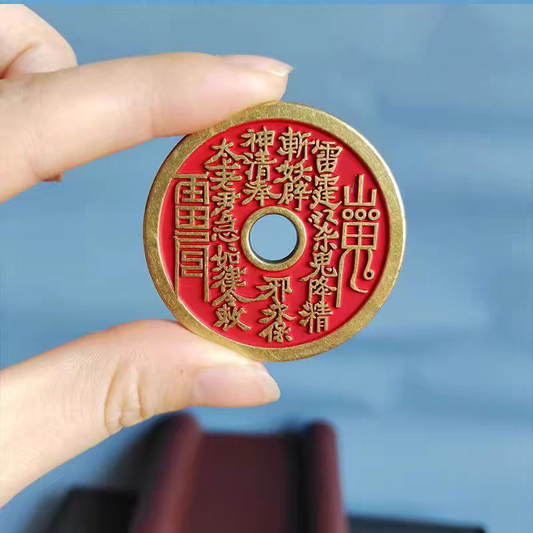
The Feng Shui Implications of the Primal Eight Trigrams and the Posterior Eight Trigrams
paulpengAktie
The Feng Shui Significance of the Primal Eight Trigrams
The ancients combined the Primal Eight Trigrams with the Five Elements and directions, making them the foundation of the art of geomancy. The sequence of the Primal Eight Trigrams is: 1 - Qian, 2 - Dui, 3 - Li, 4 - Zhen, 5 - Xun, 6 - Kan, 7 - Gen, 8 - Kun. "Zhouyi - Shuo Gua Zhuan" states: "Heaven and Earth are positioned, mountains and marshes communicate, thunder and wind interact, water and fire do not conflict. The eight trigrams are interlaced. Counting the past is in the forward sequence, knowing the future is in the reverse sequence.
Therefore, the Changes are counted in the reverse sequence." This is the theoretical basis for the orientation of the Primal Eight Trigrams and is about the matching of the trigrams themselves. The correspondence between the eight trigrams, the Five Elements, natural phenomena and directions is as follows:
·The Primal Eight Trigrams Represent Time
The Primal Eight Trigrams divide the trigrams it represents into four groups to show their relationship of opposition between Yin and Yang.
The Primal Eight Trigrams is a cosmic model derived from the River Map.
Qian and Kun represent the positioning of Heaven and Earth; Zhen and Xun represent the interaction of thunder and wind; Gen and Dui represent the communication of mountains and marshes; Kan and Li represent the non-conflict of water and fire. The Primal Eight Trigrams uses this opposition relationship to infer the operation cycle of time.
The first cycle is composed of the initial lines of the innermost circle of the eight trigrams diagram. Moving from the left of the Kun trigram indicates the Winter Solstice: the Yang begins to emerge, starting from the north. Moving from the right of the Qian trigram indicates the Summer Solstice: the Yin begins to emerge, starting from the south. One cold and one hot represent the movement of the sun in a year.
The second cycle is composed of the middle lines. Half of the Yang lines represent that the sun rises in the east, passes through the south sky and sets in the west during the day; half of the Yin lines represent the night after the sun sets. This represents the daily movement of the sun.
The third cycle is composed of the upper lines. Half of the Yin lines represent the first half of the month when the moon is waxing; half of the Yang lines represent the second half of the month when the moon is waning. This image represents a monthly cycle.
·The Posterior Eight Trigrams
The Posterior Eight Trigrams were derived by King Wen of Zhou from the Luo Shu. Although the Posterior Eight Trigrams adopt the trigrams and forms of the Primal Eight Trigrams, the trigrams are arranged according to the Luo Shu.
Except for the number "5" representing the center, which has no trigram, the eight trigrams of the Posterior Eight Trigrams respectively represent eight numbers: 1 - Kan, 2 - Kun, 3 - Zhen, 4 - Xun, 6 - Qian, 7 - Dui, 8 - Gen, 9 - Li. These eight numbers respectively represent material elements with Yin and Yang attributes. They generate and restrict each other and can achieve the balance of things by following the circulation sequence from 1 to 9.
In terms of time, the Posterior Eight Trigrams take the east where Zhen is located as the beginning of a year, representing the official arrival of spring. The eight trigrams arranged clockwise from Zhen respectively represent a year from spring to winter. Each trigram represents three solar terms, and the eight trigrams represent twenty-four solar terms. Thus, the eight trigrams become a constantly circulating calendar. More importantly, the balance reflected in the Posterior Eight Trigrams makes it an important tool for later feng shui masters to study feng shui.
The Posterior Eight Trigrams
·Fuxi's Eight Trigrams Represent Time
Fuxi's Eight Trigrams have three levels to represent time. The north corresponds to winter. After winter, all things begin to grow and a new year begins. The south symbolizes summer. After summer, life begins to mature and move towards death from its peak growth. Therefore, the first to fourth trigrams after the north all symbolize vitality " "; while the first to fourth trigrams after the south all symbolize maturity " ". Rotating clockwise in this way is a year.
The sun rises in the east and a day begins; the sun sets in the west and night begins. The middle layer of the eight trigrams is used to represent the sky. When the sun passes from the east, the first to fourth trigrams are daytime, represented by " ", and the first to fourth trigrams below the west are night, represented by " ".
The third layer of the eight trigrams represents the month. The moon wanes to full and then wanes again, exactly a month. The eight trigrams also use " " and " " to represent the waxing and waning of the moon respectively.
In this way, the cycles of year, month and day are reflected in the eight trigrams.
·The Primal Eight Trigrams and the Posterior Eight Trigrams
What are the differences between the Primal Eight Trigrams and the Posterior Eight Trigrams? They are mainly manifested in the following two aspects:
In terms of orientation, the Primal Eight Trigrams determine the north and south with Qian and Kun, and the east and west with Li and Kan. The Posterior Eight Trigrams determine the north and south with Li and Kan, and the east and west with Zhen and Dui.
In terms of manifestation, the Primal Eight Trigrams mainly show the ebb and flow and combination of Yin and Yang, the natural law and the endless generation. The Posterior Eight Trigrams show the way of the generation of the Five Elements, the change and development.









